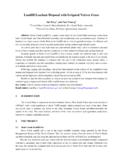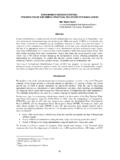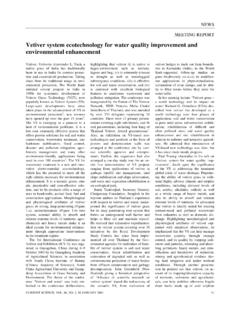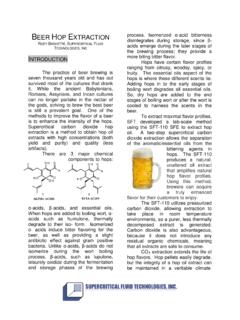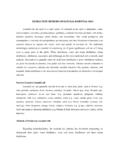Transcription of Other Uses, and Utilization of Vetiver: Vetiver Oil
1 486 Other uses , and Utilization of Vetiver : Vetiver OilU. C. LavaniaCentral Institute of Medicinal and Aromatic Plants, Lucknow 226 015, IndiaAbstract: Vetiver , a native of India is known for its perfumery and medicinal value since ancienttimes, much before the world became familiar with rose scents. The annual world trade in Vetiver oilis estimated to be around 250 tons, with Haiti, Indonesia (Java), China, India, Brazil, Japan being themain producers, and USA, Europe, India, and Japan being the main consumers. It is a gift of India tomodern world, and finds its greatest use in modern perfume creations. The essential oil distilled fromthe roots of Vetiver , is one of the most complex mixtures of sesquiterpene alcohols andhydrocarbons, and also one of the most viscous oils with an extremely slow rate of volatility.
2 Slowevaporation rate of Vetiver oil coupled with its pleasant aroma makes it a perfume by itself. Its highsolubility in alcohol that improves its miscibility with Other perfumery material, makes it uniqueperfume resource, for which no synthetic substitute is yet available. The essential oil produced indifferent countries possesses distinct odor note Reunion (Bourbon) and Haitian oil with roseatenote is highly regarded in perfumery industry, but the Vetiver (khus) oil obtained from wild Khus roots in India is considered to be the best for its balsamic woody note. Washed fresh or soakedsemidried roots when distilled by hydro-distillation / steam distillation produce an amber or darkbrown oil with a viscous texture. When the oil is distilled using traditional copper vessel inconventional slow fire stills, the oil produced is of dark green color.
3 Normally 15-18 month oldroots, harvested during December - January are most suitable to realize high concentration and goodquality of essential oil. Depending upon the biotype, cultural practice, age of roots and mode andduration of distillation, Vetiver roots may give a yield of about to 2 % essential oil on fresh rootweight basis. Under ideal steam distillation conditions the economic distillation of essential oil isrealized within 15-18 hrs, but low temperature wood-fired distillers may require over 24 hrs. Lately,molecular extraction by liquid carbon dioxide is gaining preference over hydro-distillation methodsto realize high-grade essential composition of Vetiver oil is extremely complex, mainly comprising ofsesquiterpenes and sesquiterpene derivatives, of which vetiverols, their carbonyl compounds andesters, are the main constituents, and their relative abundance normally establishes the oil carbonyl compounds, _-vetivone, _-vetivone and khusimone, are considered the primaryodor-influencing components; _-vetivone has the better odor, and is considered the most important,while its major isomer nordihydro _-vetivone has a strong, rich, woody-peppery note.
4 The oil andits constituents are used extensively for blending oriental type of perfumes and floral compounds, aswell as in Other cosmetic and aromatherapy applications. It is very persistent and one of the finestfixatives known. Vetiver oil is a main ingredient in 36 % of all western quality perfumes and 20 % ofall men s fragrances. Dried roots are used as sachets / stuffing material to prepare ventilating screensthat provide cool air effect and pleasant aroma when words: Khus oil, Vetiver oil, Vetiver perfume, essential oil, Vetiver roots, perfume fixative,perfume blender, aromatic plant, aromatherapyE-mail contacts: Lavania and INTRODUCTIONV etiver is the omni-useful plant, almost all parts of which are used in one or more ways havingdirect as well as multifarious cultural and industrial applications.
5 Of course, the commercial and socialutility of this plant was first realized on account of its aromatic roots, and lately overwhelmed byenvironmental applications of the plant as such, as well as diverse industrial uses of above ground487plant parts (Chomchalow and Chapman, 2003) . The essential oil obtained from the roots of vetiveris the major source of national economy of at least two nationalities Haiti Island in the Caribbeanand Reunion island in the Indian Vetiver ROOT AND ROOT-OILThe roots originating from Vetiver clumps comprise of tufted fibrous mass. Tremendousdiversity exists with respect to pattern of growth, orientation and thickness of roots, as well as foroccurrence of secondary roots. The bast region of root is the source of essential Natural Diversity and Cultivation of Vetiver for Root OilVetiver is native to India and is found in wild state throughout the Indian subcontinentencompassing temperate to tropical climate.
6 For various economic purposes including extraction ofessential oil, the roots are dug out from wild resources in northern India, but are obtained undercultivation in south India, and several Other countries. Haiti island in the Caribbean is the majorsource for the supply of Vetiver oil to the world market, followed by Java (Indonesia), China, Japan,India etc. Depending upon the country of occurrence, cultivation practices, climatic conditions, andgenetic origin, there occurs tremendous diversity with respect to yield and quality of essential oil,ranging from earthy woody balsamic note to sweet roseate Cultivation for Roots and Root-oilTraditionally, in India Vetiver roots are obtained by manual digging from about two year oldplants occurring in wild to extract high perfumery grade essential oil, called as khus oil , but in southIndia and elsewhere in Other countries Vetiver is grown under cultivation.
7 For optimum growth thevetiver plant requires long day conditions and plenty of sunlight. Under irrigated conditions vetiverplantations are established any time during the year, but for rain-fed conditions it is advisable thatplantations should be established with the onset of rains. In poor soils and waste lands high plantpopulation at 60 x 45 cm plant to row distance may be desirable, and less with improved soil andcultural conditions. During growth period shoots 25 - 30 cm above the ground need to be harvestedintermittently during slow growth period of low temperature conditions. Since, digging of soil forroot harvesting may be environmentally undesirable, an alternative means of growing Vetiver couldbe in poly-bags and Other containers (Chomchalow, 2001).
8 This would not only mitigate soil erosionconcerns but also increase cost benefit ratio of Vetiver cultivation for its roots and root oil, as well asoptimum Utilization of degraded lands as poly-bag platforms. 15 18 month old roots are ideal for torealize good oil quality and high oil Distillation and Processing of Essential OilAge, quality and stage of root harvest, and processing for distillation are vital components forefficient processing of essential oil distillation. Essential oil could be distilled both from fresh anddried roots. Recovery of essential is very high from fresh roots, but leaving the roots in open for 2 3 days after harvesting with a day temperature of around 25 C yields high quality essential oil, sincethe undesirable non-polar low boiling components of the oil are naturally evaporated off, althoughoil recovery is somewhat reduced.
9 Both freshly harvested roots and semidried roots soaked overnightin water could be used for essential oil methods of distillation are traditionally practiced in India (Singh and Singh, 1998). Theone for an on site distillation is Bhapka system which is quite common in north India. Thedistillation equipment consists of a round bottom copper still Deg and a receiver Bhapka alsomade of copper. The Deg is connected with Bhapka by a bamboo called Chonga . The Chonga serves the purpose of a pipe to allow the steam to reach to the Bhapka from Deg forcondensation. The Bhapka is placed in a small water tank for cooling. Depending upon the size ofthe Deg 50 100 kg of semidried roots could be distilled. Although, the recovery of oil by488 Bhapka system is lower and the distillation requires 4 - 5 hours longer than the Other methods ofdistillation, but the quality of the oil thus recovered is of much superior quality.
10 Other methods ofdistillation make use of steam generating boilers and direct wood fired distillers. In directly fireddistillers the water coming from the separators may be cohobated. The oil recovered from slow fired Bhapka distillers is usually light to- dark green in color, whereas the one obtained from boileroperated and directly fired stills is yellowish brown in color. For optimum recovery and economicproductivity of oil, it is suggested that roots may be harvested when the maximum day temperature is25 - 27 C, roots be distilled at the earliest after the harvest, and distillation performed just for about15 hrs, and age of roots around 18 months (Aggarwal et al., 1998; Lavania, 2003).In order to improve quality and increase shelf life, the freshly distilled oil need to bedehydrated to remove water either by anhydrous sodium sulphate or natural evaporation by airdrying, and then allowed to mature by natural oxidation for about six months in amber color glassbottles with a bit of air trapped inside the container till it develops green coloration.

